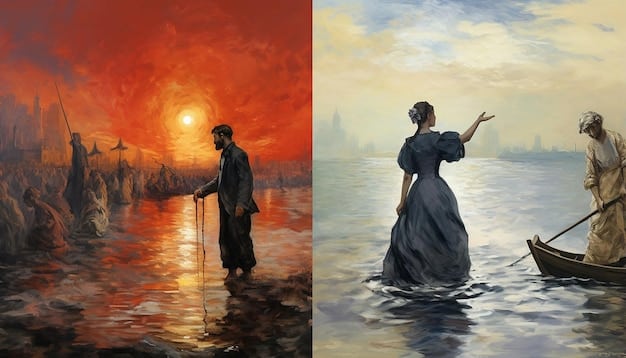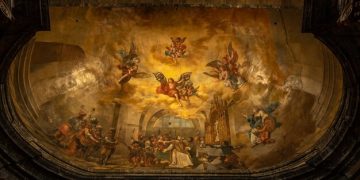Rediscovering Édouard Manet: A Forgotten Masterpiece of Impressionism

Édouard Manet, a pivotal figure in the transition from Realism to Impressionism, left an indelible mark on modern art with his innovative techniques and provocative subject matter, challenging established norms and paving the way for future artists.
Step into the world of Édouard Manet, a revolutionary artist whose work bridged the gap between Realism and Impressionism. Though often overshadowed, his genius deserves rediscovery. Join us as we delve into the life, techniques, and lasting impact of this master.
Édouard Manet: The Bridge Between Worlds
Édouard Manet, born in Paris in 1832, stands as a crucial figure in art history. He wasn’t just an artist; he was a bridge, connecting the traditions of Realism with the burgeoning Impressionist movement. Manet’s unique approach and bold artistic choices challenged the status quo.
Early Life and Artistic Training
Manet’s journey began with a conventional art education. Despite initial resistance from his father, who envisioned a career in law, Édouard pursued his passion for art. He studied under Thomas Couture, a history painter, for six years.
His time with Couture provided him with a solid foundation in technique, but Manet soon grew restless. He sought inspiration from the masters, spending countless hours copying their works in the Louvre and traveling to museums throughout Europe.
- Studied under Thomas Couture, learning traditional painting techniques.
- Copied masterpieces in the Louvre, absorbing artistic influences.
- Traveled extensively to museums across Europe, broadening his artistic horizons.
Manet’s early training instilled in him a deep understanding of artistic tradition, which he would later both embrace and challenge, creating a style uniquely his own.
Édouard Manet’s impact on the art world is undeniable. His ability to blend traditional techniques with modern subject matter set him apart from his contemporaries, making him both a controversial and celebrated figure. This unique approach paved the way for the Impressionist movement.

The Shocking “Le Déjeuner sur l’herbe”
“Le Déjeuner sur l’herbe” (The Luncheon on the Grass), completed in 1863, is arguably Manet’s most controversial and iconic work. It sparked outrage and debate when it was first exhibited at the Salon des Refusés, an exhibition for works rejected by the official Salon.
Breaking Conventions
The painting depicts a nude woman casually lunching with two fully clothed men in a park setting. This blatant disregard for academic conventions of idealized nudes and historical or mythological subject matter scandalized viewers. Manet’s choice of contemporary figures in modern dress, coupled with the nude woman’s direct gaze, challenged the traditional power dynamics and expectations of art.
Artistic Innovations
Beyond the controversial subject matter, “Le Déjeuner sur l’herbe” also showcased Manet’s innovative painting techniques. He flattened the perspective, using a brighter, more direct light, and eliminated traditional chiaroscuro, the contrast between light and shadow. These techniques contributed to the painting’s modern feel and further distanced it from academic art.
- Depicts a nude woman with clothed men, challenging traditional art norms.
- Showcased at the Salon des Refusés, sparking controversy.
- Employs flattened perspective and direct light, innovative for the time.
The painting’s impact extends beyond its initial shock value. “Le Déjeuner sur l’herbe” is now recognized as a pivotal work in the development of modern art. It challenged the established norms and paved the way for future artists to explore new subjects and techniques.
Manet’s “Le Déjeuner sur l’herbe” challenged the art world with its bold subject matter and innovative techniques. The controversy it ignited solidified Manet’s position as a leading figure in the shift towards modern art, influencing generations of artists to come.
Olympia: A Modern Venus
Following closely on the heels of “Le Déjeuner sur l’herbe,” Manet’s “Olympia,” painted in 1863 and first exhibited in 1865, continued to provoke and challenge the art world. This painting presented another contemporary take on a classical subject, further cementing Manet’s reputation as a revolutionary artist.
Reinterpreting the Classical Nude
“Olympia” depicts a reclining nude woman, a direct reference to Titian’s “Venus of Urbino.” However, Manet’s “Olympia” is not a goddess or an idealized figure; she is a modern woman, a courtesan, lying on a bed, attended by a black servant offering her flowers. The painting’s realism and contemporary setting again challenged the idealized and often allegorical nudes of academic art.
A Symbol of Modernity
The painting’s composition and details also contributed to its modernity. Olympia’s direct gaze, devoid of coyness or shame, challenges the viewer. The angularity of her body and the sharp contrasts in light and shadow further distance her from the soft, idealized forms of classical nudes. The black cat at the foot of the bed, a symbol of independence and sexuality, adds another layer of meaning to the painting.
- Reinterprets Titian’s “Venus of Urbino” with a modern courtesan.
- Features sharp contrasts and angular forms, deviating from classical ideals.
- Includes a black cat, symbolizing independence and sexuality.
“Olympia” forced viewers to confront the realities of modern life and challenged their preconceived notions of beauty and art. It became a symbol of the changing times and Manet’s unwavering commitment to portraying the world around him with honesty and artistic innovation.
“Olympia” remains a powerful and relevant work. Its impact on art history is undeniable, and it continues to inspire debate and discussion about the representation of women, sexuality, and modernity.
The Impressionist Influence
While Manet himself never officially joined the Impressionist group, he played a significant role in their development and shared many of their artistic concerns. His influence on the Impressionists is undeniable, and he often exhibited alongside them.
Shared Artistic Concerns
Manet and the Impressionists shared an interest in capturing the fleeting moments of modern life, portraying the world around them with honesty and immediacy. They rejected the historical and mythological subjects favored by the Academy and instead focused on everyday scenes, landscapes, and portraits of contemporary figures.
They also shared a commitment to painting en plein air, directly from nature, and experimenting with new techniques to capture the effects of light and atmosphere. Manet’s use of loose brushstrokes, bright colors, and flattened perspective paved the way for the Impressionist style.
- Rejected historical subjects, focusing on contemporary life.
- Painted en plein air, capturing fleeting moments in nature.
- Employed loose brushstrokes and bright colors, influencing Impressionism.
Though Manet’s style remained distinct from that of the Impressionists, his influence on their development is undeniable. He provided them with inspiration, encouragement, and a model for challenging the established norms of the art world.
Édouard Manet’s influence extended to artists like Claude Monet, Auguste Renoir, and Edgar Degas, who were all deeply inspired by his innovative techniques and modern subject matter. His role as a predecessor and mentor is a testament to his lasting impact.

Later Works and Legacy
In his later years, Manet continued to explore new subjects and techniques, producing a diverse body of work that included portraits, genre scenes, and still lifes. His paintings of Parisian nightlife, such as “A Bar at the Folies-Bergère,” captured the energy and excitement of the modern city.
Portraits of Prominent Figures
Manet was a sought-after portrait painter, capturing the likenesses of many prominent figures of his time, including Émile Zola, Stéphane Mallarmé, and Georges Clemenceau. His portraits are characterized by their psychological insight and artistic skill.
Lasting Impact on Art History
Édouard Manet died in 1883 at the age of 51, leaving behind a legacy that continues to inspire artists today. His work challenged the established norms of the art world and paved the way for the development of modern art. Manet’s influence can be seen in the works of countless artists who followed, from the Impressionists to the Post-Impressionists and beyond.
- Painted portraits of Émile Zola, Stéphane Mallarmé, and Georges Clemenceau.
- Captured the energy of Parisian nightlife in paintings like “A Bar at the Folies-Bergère.”
- Paved the way for modern art, inspiring artists from Impressionists to Post-Impressionists.
Manet’s art continues to resonate with audiences today, not only for its beauty and technical skill but also for its relevance to contemporary issues of identity, representation, and social change.
Édouard Manet’s work has transcended time, remaining relevant and influential in the art world. His legacy extends beyond his paintings, inspiring generations of artists to challenge conventions and explore new forms of expression.
Rediscovering the Master
Today, Édouard Manet is recognized as one of the most important artists of the 19th century. His paintings are displayed in major museums around the world, and his legacy continues to inspire artists and art lovers alike.
Preserving Manet’s Work
Efforts to preserve, study, and promote Manet’s work are ongoing. Art historians continue to uncover new insights into his life and art, and museums regularly mount exhibitions showcasing his masterpieces.
Why Manet Matters Today
Manet’s work remains relevant today because it speaks to universal themes of human experience, such as beauty, desire, and social inequality. His paintings challenge viewers to see the world in new ways and to question established norms.
- His paintings are displayed in major museums globally.
- Ongoing efforts preserve and promote his artistic legacy.
- His work addresses universal themes, remaining relevant today.
By rediscovering Manet, we can gain a deeper understanding of the history of art and the ongoing power of art to transform our perceptions of the world.
Édouard Manet’s position in art history is secure, yet his works continue to provoke thought and inspire admiration. He remains a vital figure, encouraging us to challenge norms and appreciate the beauty of the world around us.
| Key Aspect | Brief Description |
|---|---|
| 🎨 Artistic Style | Transitioned Realism to Impressionism, innovative techniques. |
| 🖼️ Key Works | “Le Déjeuner sur l’herbe,” “Olympia,” scandalous and influential. |
| 🏛️ Impact | Challenged norms, influenced Impressionists, inspired generations. |
| 👤 Legacy | Continues to inspire artists, museums worldwide display his art. |
Frequently Asked Questions About Édouard Manet
▼
Manet is best known for his pivotal role in the transition from Realism to Impressionism, and for his controversial yet influential paintings like “Le Déjeuner sur l’herbe” and “Olympia”.
▼
Manet influenced the Impressionists through his focus on contemporary subjects, his innovative painting techniques (like loose brushstrokes), and his commitment to challenging established artistic norms.
▼
“Le Déjeuner sur l’herbe” was controversial because it depicted a nude woman casually picnicking with clothed men, a blatant disregard for academic art conventions and societal expectations.
▼
While Manet shared artistic concerns with the Impressionists and exhibited with them, he never officially joined the group, maintaining a distinct style that blended Realism with the emerging Impressionist techniques.
▼
Édouard Manet’s paintings are displayed in major museums around the world, including the Musée d’Orsay in Paris, the Metropolitan Museum of Art in New York, and the National Gallery in London.
Conclusion
Édouard Manet’s artistic contributions were transformative, bridging traditional techniques with modern sensibilities. His legacy challenges us to question norms, appreciate the beauty of everyday life, and continually rediscover the masters who shaped art history.





